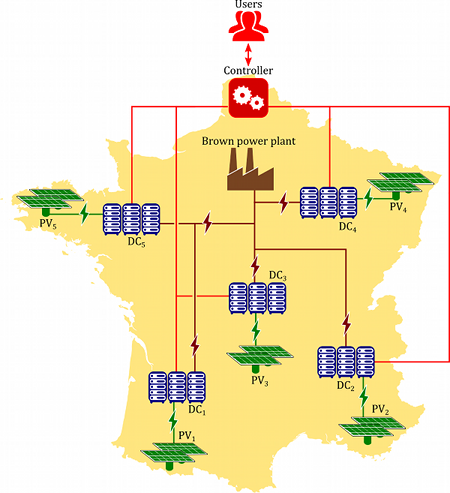Coordinated Optimization of SMart grIds and Clouds

COSMIC Project
The COSMIC project is an Inria exploratory action on Coordinated Optimization of SMart grIds and Clouds (2016-2018).
Project
COSMIC Project
The distributed nature of Cloud infrastructures involves that their components are spread across wide areas, interconnected through different networks, and powered by diverse energy sources and providers, making overall energy monitoring and optimization challenging. The COSMIC project takes advantage of the opportunity brought by the Smart Grids to:
- exploit renewable energy availability
- optimize energy management in distributed Clouds.
Results
Results
Context
The energy drawn by Cloud data centers is reaching worrying levels, thus inciting providers to install on-site green energy producers, such as photovoltaic panels. Considering distributed Clouds, workload managers need to geographically allocate virtual machines according to the green production in order not to waste energy. In this project, we consider a distributed Cloud infrastructure comprising several data centers geographically distributed and powered by the regular electrical grid on one side and on-site photovoltaic panels on the other side. The user management of the Cloud is assumed to be centralized as shown on the figure below.
The considered Cloud architecture

SAGITTA: a Stochastic Approach for Green consumption In disTributed daTA centers
As a first approach, we consider the problem of scheduling workload across multiple data centers for minimizing renewable energy loss. To solve this issue, we propose SAGITTA: a Stochastic Approach for Green consumption In disTributed daTA centers. SAGITTA uses a stochastic approach for estimating renewable energy production, and a greedy heuristic for allocating resources to the incoming user requests. Our simulation-based results show the efficiency of SAGITTA compared to classical allocation approaches. Indeed, compared to the optimal solution, SAGITTA consumes 4% more energy overall, and wastes only 3.14% of the available green energy, while a classical round-robin solution consumes 14.4% more energy overall than optimum, and wastes 28.83% of the available green energy. More details can be found in [CDO17].
Co-simulation of FMUs and Distributed Applications with SimGrid
SimGrid is a versatile platform for the simulation of distributed systems which embeds a set of rigorously validated IT models (e.g. CPU, IP network, disk, energy consumption). The platform manages the co-evolution and the interaction between these models and the different concurrent processes that compose a distributed application code. Since 2010, the Functional Mock-up Interface (FMI) standard of the Modelica Association is becoming an essential solution toward co-simulation. It offers a unified framework and an API to control equation-based models of multi-physical systems (e.g. electrical, mechanical, thermal systems). The FMI-compliant tools enable (1) to design a model and export it as an FMU (Functional Mock-up Unit) –i.e. a simulation unit compliant with FMI– (2) and/or to import and use an FMU as a component in their modeling environment. In this work, we specify an FMU as a SimGrid model to ease the simulation of distributed data centers including their Computer Room Air Handler (CRAH). More details can be found in [COQ18].
People
People
- Anne Blavette (CNRS, SATIE)
- Benjamin Camus (Inria, IRISA)
- Fanny Dufossé (Inria, LIG)
- Anne-Cécile Orgerie (CNRS, IRISA, project leader)
- Martin Quinson (ENS Rennes, IRISA)
Publications
Publications
-
[CDO18] “The SAGITTA approach for optimizing solar energy consumption in distributed clouds with stochastic modeling” Benjamin Camus, Fanny Dufossé, and Anne-Cécile Orgerie chapter in Smart Cities, Green Technologies, and Intelligent Transport Systems, pages 52-76, Springer (ISBN 978-3-030-02906-7), December 2018. Available here.
-
[CAD18] “Harnessing the geographical flexibility of distributed computing clouds for cooperative self-consumption”
Benjamin Camus, Anne Blavette, Fanny Dufossé and Anne-Cécile Orgerie
ISGT Europe: IEEE PES Innovative Smart Grid Technologies Conference Europe, Sarajevo, Bosnia and Herzegovina, October 2018, online version. -
[CDB18] “Network-aware energy-efficient virtual machine management in distributed Cloud infrastructures with on-site photovoltaic production”
Benjamin Camus, Fanny Dufossé, Anne Blavette, Martin Quinson and Anne-Cécile Orgerie SBAC-PAD: International Symposium on Computer Architecture and High Performance Computing, Lyon, France, pages 85-92, September 2018, online version. -
[CBD18] “Self-Consumption Optimization of Renewable Energy Production in Distributed Clouds”
Benjamin Camus, Anne Blavette, Fanny Dufossé and Anne-Cécile Orgerie
Cluster: IEEE Cluster Conference, Belfast, United Kingdom, pages 359-369, September 2018, online version. -
[COQ18] “Co-simulation of FMUs and Distributed Applications with SimGrid”
Benjamin Camus, Anne-Cécile Orgerie and Martin Quinson PADS: ACM SIGSIM Conference on Principles of Advanced Discrete Simulation, Roma, Italy, pages 145-156, May 2018, online version. -
[CDO17] “A stochastic approach for optimizing green energy consumption in distributed clouds”
Benjamin Camus, Fanny Dufossé and Anne-Cécile Orgerie SMARTGREENS: International Conference on Smart Cities and Green ICT Systemsi, Porto, Portugal, pages 47-58, April 2017, online version.